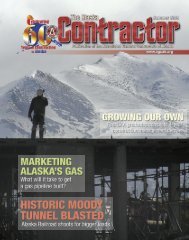201212_UTMinuteman_W.. - Keep Trees
201212_UTMinuteman_W.. - Keep Trees
201212_UTMinuteman_W.. - Keep Trees
You also want an ePaper? Increase the reach of your titles
YUMPU automatically turns print PDFs into web optimized ePapers that Google loves.
Homeland Response Force “Eats Elephant”<br />
Story and photos by Maj. Wencke Tate<br />
CAMP WILLIAMS, Utah — At the end of the Region<br />
VIII Homeland Response Force’s two-week Annual Training<br />
at Camp Williams in July, the staff breathed a sigh of relief<br />
and gave a little cheer when the briefing slide came up during<br />
the after-action review recommending the Utah HRF for<br />
validation.<br />
“Throughout the past two years of standing up the<br />
Homeland Response Force, we focused on eating this<br />
elephant one bite at a time,” said Col. Milada Copeland, 97th<br />
Troop Command and Region VIII HRF commander. “Things<br />
only look monumental if you don’t force yourself to lay out<br />
a road map and stick to it. Our successful validation is a<br />
testament to how good the staff was at sticking to that road<br />
map of taking this process step by step.”<br />
And that is exactly what they did, took it step by step.<br />
For Utah, the building of this new mission from National<br />
Guard Bureau started at the end of 2010 with four staff<br />
members hired to start laying out the groundwork to have a<br />
fully operational and ready HRF. By June 2012, the program<br />
grew to approximately 560 Soldiers and Airmen, 60 of them<br />
full time.<br />
Lt. Col. Mel Anderson, program manager and deputy<br />
commander of the Utah National Guard HRF, said Utah<br />
is recognized nationwide as the only HRF being stoodup<br />
from the ground up, with no existing CERFP (chemical,<br />
biological, radiological, nuclear, and explosive-<br />
Enhanced Response-Force Package).<br />
“The learning curve was so steep that it was obvious we<br />
would either fly out the other side with a hugely successful<br />
evaluation or we’d burn in face first and crash. It was an<br />
adrenaline rush for 18 months,” he added. “Being part of this<br />
monumental effort is far more than personally rewarding.”<br />
Capt. Jennifer Cavalli from the HRF Security Element,<br />
141st Military Intelligence Battalion, calms down an angry<br />
crowd. Role players were hired to give reality to the exercise.<br />
22 Winter 2012<br />
The HRF is a Department of Defense asset and is hosted by one<br />
state in each of the ten Federal Emergency Management Agency,<br />
(FEMA) regions. According to a DoD fact sheet, HRFs will increase<br />
the focus of DoD Chemical, Biological, Radiological, Nuclear, and<br />
High explosive (CBRNE) consequence management response forces<br />
on lifesaving objectives. It also increases operational flexibility<br />
while recognizing the primary role that governors play in controlling<br />
responses to CBRNE incidents that occur in their state.<br />
Copeland believes the HRF is a very powerful tool that the National<br />
Guard should maintain and improve. As much as it is valuable for its<br />
technical and lifesaving ability, it also brings huge value because it<br />
gives all of us a sense of contribution and a sense of accomplishment.<br />
It involves the Guard even more in the domestic response structure<br />
of the community we live in, provides another avenue to train with<br />
first responders, and strengthens the entire community’s sense of selfreliance<br />
and ability to mitigate whatever danger comes along. She<br />
admits that the last point, while difficult to measure, is very valuable<br />
and will improve any response we have to provide.<br />
Major Ryan King, a full-time civilian police officer was one of<br />
the first hired for this mission as the brigade logistics officer, handling<br />
heavy logistics duties to build the HRF and is now the HRF executive<br />
officer. His experience as a first responder gives him a unique<br />
perspective.<br />
“I found this mission truly provides a service to our nation and our<br />
citizens. The mission set is very similar to that of any first-responder<br />
organization and fills a critical void in capabilities both locally and<br />
nationally,” said King.<br />
“The HRF is the organization that is called on in a crisis when<br />
other local and state assets have been exhausted or are not capable of<br />
meeting the needs of the incident. We are the go-to guy, when all else<br />
fails,” King continued. “That is a huge challenge, but we are prepared<br />
and continue to be ready to take on that challenge.”<br />
Members of the 115th Maintenance Company spray<br />
down after their shift to remove any contaminants.

















